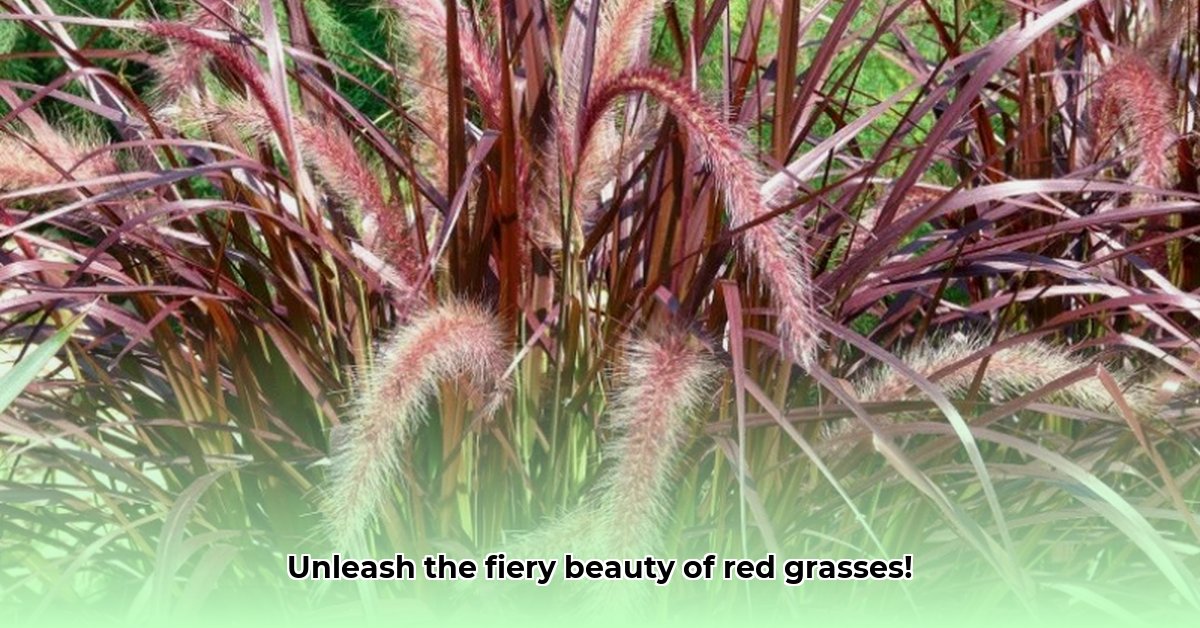
Want to inject vibrant color and captivating texture into your landscape? Ornamental red grasses offer a stunning solution, adding fiery accents and graceful movement to any garden. But with a wide array of options, selecting the perfect variety can feel daunting. This comprehensive guide simplifies the process, empowering you to create a breathtaking outdoor space. We'll cover everything from choosing the right grass based on your climate and soil conditions to planting, care, and creative landscaping ideas. For even more inspiration, check out this helpful guide.
Selecting the Perfect Red Grass: Key Considerations
Before diving into specific varieties, understanding your garden's environment is crucial. Several key factors influence your choice:
Hardiness Zone (Climate): Your hardiness zone, determined by your average minimum winter temperature, dictates which grasses will survive. Consult the USDA Plant Hardiness Zone Map to find yours. Choosing a grass suited to your zone is essential for its long-term health.
Sunlight: Most red ornamental grasses thrive in full sun (at least six hours of direct sunlight daily). While some tolerate partial shade, full sun generally yields the most intense color. Consider the sun exposure of your planting location carefully.
Soil Drainage: Well-drained soil is paramount. Poor drainage leads to root rot, a common killer of ornamental grasses. If your soil is heavy clay, amend it with compost (organic matter) to improve drainage and aeration.
Mature Size: Red grasses range from compact groundcovers to towering specimens. Measure your planting area to ensure the grass has ample space to mature without overcrowding other plants. A small grass in a large space will look out of place.
Maintenance: Consider your time commitment. Some varieties require minimal care, while others need regular watering, fertilization, and pruning. Choose a grass that aligns with your maintenance capabilities.
Popular Ornamental Red Grass Varieties: A Closer Look
Let's explore some exceptional red grass varieties, highlighting their characteristics and ideal uses:
1. Japanese Blood Grass (Imperata cylindrica 'Rubra'): This striking grass boasts vibrant crimson blades, particularly intense during cooler months. Relatively low-maintenance, it thrives in full sun and well-drained soil (Hardiness Zones 7-10). Perfect for borders, containers, or as a dramatic accent. Its bright color makes it a standout in any garden.
2. Purple Fountain Grass (Pennisetum setaceum 'Rubrum'): Known for its deep reddish-purple flower plumes and attractive foliage, this visually stunning grass reaches 3-5 feet tall. It demands full sun and well-drained soil (Hardiness Zones 7-11), requiring moderate maintenance. Its height and striking plumes make it an excellent focal point.
3. Kochia scoparia (Summer Cypress): Although not technically a grass, Kochia scoparia deserves mention for its fiery red autumn foliage. This annual requires full sun and well-drained soil and is easily grown from seed. It's a great choice for temporary bursts of color in all hardiness zones. It's a low-maintenance and beautiful temporary solution for red color in your garden.
4. Red Switchgrass (Panicum virgatum 'Shenandoah'): A native North American grass, 'Shenandoah' offers a beautiful reddish-bronze hue in fall, transitioning to a lovely green in summer. It tolerates various soil conditions and thrives in full sun (Hardiness Zones 4-9). This low-maintenance option is also beneficial for wildlife. Native grasses are becoming increasingly popular for their ecological benefits.
Planting and Caring for Your Red Grass: A Step-by-Step Guide
Successfully establishing your red grass involves these key steps:
Site Preparation: Choose a sunny location with well-drained soil. Amend heavy clay soils with compost to improve drainage. Proper site preparation is key to success.
Planting: Plant according to the spacing recommendations on the plant label or nursery instructions. Water thoroughly after planting to help the roots settle.
Watering: Keep the soil consistently moist, especially during dry spells, but avoid overwatering, which can lead to root rot. Monitor soil moisture levels and adjust watering schedules accordingly.
Fertilizing: A light spring fertilization can boost color and growth. Avoid excessive nitrogen, which can promote weak, leggy growth. Proper fertilization is important for healthy growth and vibrant color.
Pruning: In late winter or early spring, cut back any dead or brown foliage. Some varieties benefit from regular trimming to maintain their shape.
Comparing Popular Ornamental Red Grass Varieties: A Quick Reference
| Variety | Mature Height (ft) | Sunlight | Hardiness Zones | Maintenance Level | Color Highlights |
|---|---|---|---|---|---|
| Japanese Blood Grass | 1-3 | Full Sun | 7-10 | Low | Intense crimson, especially in cooler months |
| Purple Fountain Grass | 3-5 | Full Sun | 7-11 | Moderate | Reddish-purple plumes and foliage |
| Kochia scoparia | 2-4 | Full Sun | All | Low | Fiery red in autumn, green in summer |
| Red Switchgrass ('Shenandoah') | 4-6 | Full Sun | 4-9 | Low | Reddish-bronze in fall, green in summer |
This table provides a quick comparison to help you choose the best fit for your garden.
Designing with Your New Red Grasses: Unleash Your Creativity!
Red ornamental grasses add more than just color; they bring texture and movement to your landscape. Consider these creative uses:
- Borders: Define garden beds or pathways with a vibrant edge.
- Accents: Highlight focal points or architectural features.
- Mass Plantings: Create a dramatic statement with a large group of a single variety.
- Container Gardens: Add color and texture to patios, decks, or balconies.
Experiment with diverse textures and colors to create a visually appealing and dynamic garden. Remember to consider the mature size to avoid overcrowding.
Ready to transform your garden with the vibrant beauty of red ornamental grasses? Visit your local nursery or explore online retailers to find the perfect varieties for your space. Happy gardening!